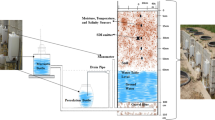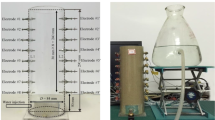Abstract
This study was carried out at the experimental field station of the Atomic Energy Authority in Anshas, Egypt, by the aim of assessing the soil moisture status under surface and subsurface drip irrigation systems, as a function of the variation in the distance between drippers along and between laterals. Moisture measurements were carried out using neutron moisture meter technique, and water distribution uniformity was assessed by applying Surfer Model. The presented data indicated that the soil moisture distribution and its uniformity within the soil profile under surface drip was to great extent affected by the distance between drippers rather than that between laterals. Generally, the soil moisture distribution under using 30-cm dripper spacing was better than of that under 50 cm. Under subsurface drip irrigation, the allocation of the irrigation system was the factor that dominantly affected the moisture trend under the studied variables. Installing the system at 30 cm from the soil surface is the one to be recommended as it represents the active root zone for most vegetable crops, beside it leads to a better water saving in sandy soils than that allocated at 15 cm depth.












Similar content being viewed by others
References
Allen RG, Willardson LS, Frederiksen HD (1997) Water use definition and there for assessing the impacts of water conservation. In: Sustainability irrigation in areas of water scarcity and drought, proceedings of the ICID workshop, Oxford, pp 72–81
ASAE Standards (2002) EP405: design and installation of microirrigation system. ASAE, St. Joseph
Burt CM, Styles SW (1994) Drip and microirrigation for trees, vines, and row crops, with special sections on buried drip. Irrigation Training and Research Center, Cal Poly, San Luis Obispo, CA. ISBN 0-9643634-0-2
Burt CM, Clemmens AJ, Strelkoff TS, Solomon KH, Bliesner RD, Hardy LA, Howell TA, Eisenhauer DE (1997) Irrigation performance measures—efficiency and uniformity. J Irrig Drain Eng ASCE 123:423–442
Camp CR (1998) Subsurface drip irrigation: a review. Trans ASAE 41(5):1353–1367
Chanasyk DS, Naeth MA (1996) Field measurement of soil moisture using neutron probes. Can J Soil Sci 76:317–323
Clothier BE, Green SR (1994) Root zone processes and the efficient use of irrigation water. Agric Water Manag 25(1):1–12
Clothier BE, Green SR (1997) Roots: the big movers of water and chemicals in soil. Soil Sci 162:534–543
Elmaloglou S, Diamantopoulos E (2009) Simulation of soil water dynamics under subsurface drip irrigation from line sources. Agric Water Manag 96(11):1587–1595
Grote K, Hubbard SS, Rubin Y (2003) Field-scale estimation of volumetric water content using GPR ground wave techniques. Water Resour Res 139(11):13–21
Huisman JA, Snepvangers JJJC, Bouten W, Heuvelink GBM (2002) Mapping spatial variation in surface soil water content: comparison of ground-penetrating radar and time domain reflectometry. J Hydrol 207:194–207
Keller J, Karmeli D (1974) Trickle irrigation design parameters. Trans ASAE 17:678–784
Klute A (1986) Methods of soil analysis. Part 1. Physical and mineralogical met hods, 2nd edn. American Society of Agronomy Inc, Madison, pp 463–478
Lazarovitch N (2001) The effect of soil water potential, hydraulic properties and source characteristic on the discharge of a subsurface source. Thesis submitted to the Faculty of Agriculture of the Hebrew University of Jerusalem
Lunt IA, Hubbard SS, Rubin Y (2005) Soil moisture content estimation using ground-penetrating radar reflection. J Hydrol 307(1–4):254–269
Schmugge TJ, Jackson TJ, McKim HL (1980) Survey of methods for soil moisture determination. Water Resour Res 16:961–979
Shani U, Or D (1995) In situ method for estimating subsurface unsaturated hydraulic conductivity. Water Resour Res 31:1863–1870
Souza C, Folegatti M, Or D (2009) Distribution and storage characterization of soil solution for drip irrigation. Irrig Sci 27(4):277–288
Western AW, Grayson RB (1998) The Tarrawarra data set: soil moisture patterns, soil characteristics, and hydrological flux measurements. Water Resour Res 34(10):2765–2768
Author information
Authors and Affiliations
Corresponding author
Additional information
Communicated by A. Kassam.
Rights and permissions
About this article
Cite this article
Badr, A.E., Abuarab, M.E. Soil moisture distribution patterns under surface and subsurface drip irrigation systems in sandy soil using neutron scattering technique. Irrig Sci 31, 317–332 (2013). https://doi.org/10.1007/s00271-011-0306-0
Received:
Accepted:
Published:
Issue Date:
DOI: https://doi.org/10.1007/s00271-011-0306-0




